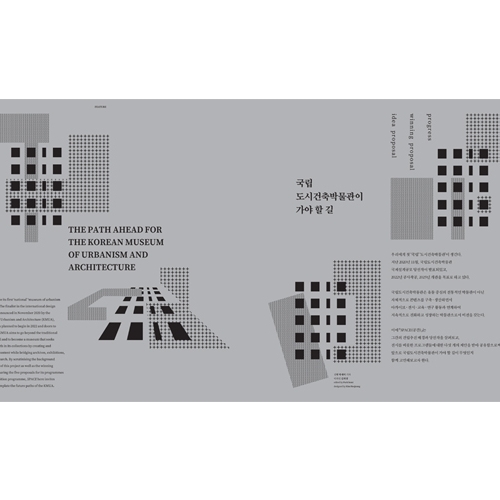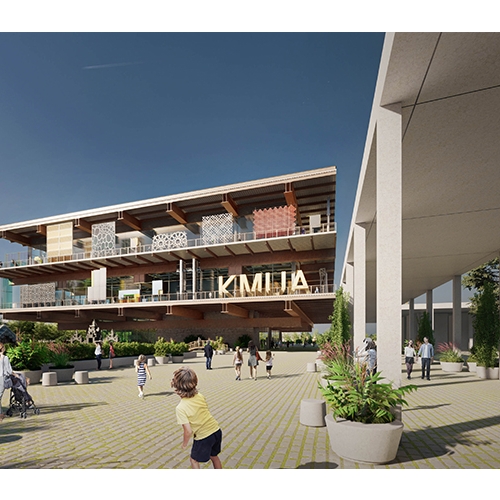An Architecture Museum is not an Architecture Museum : A Plea for a Public Forum on the Korean Museum of Urbanism and Architecture
An architecture museum is full of contradictions. Unlike that of art or design museums, in which original works or objects of value as such are collected and displayed, an architecture museum only deals with secondary representation of the subject at hand: documents that lead to architecture, such as plans and models, or documentation of architecture, like photography. Kim Swoo Geun’s glasses become more valuable than a photograph of the Kyungdong Presbyterian Church. There is no actual architecture in an architecture museum. Therefore, architecture exhibitions are arguably fundamentally flawed.
In 1929 for the 2nd CIAM exhibition ‘Die Wohnung fur das Existenzminimum’ (The Dwelling for Minimal Existence) Ernst May invented the ‘traveling exhibition’ to reach a wider audience by sending this exhibition through Europe. In order to achieve this he reduced the representation of architectural works to plans, models, and photos; flexible entities that can be easily shipped. In knowledge of this exhibition, Philip Johnson refined this concept for his 1932 exhibition ‘The International Style’ and established what we today associate with an architecture exhibition: plans, models, photos, texts, documents; artifacts that cannot communicate the essence of architecture but simply narratives about architecture. This fact makes an architecture museum a historical museum, displaying fragments in order to tell a story that might otherwise not be made tangible. And yet historical events are in the past, while architecture can still be in the now just a few kilometres away. An architecture museum simulates, reduces, substitutes, or de-contextualizes architecture. Which raises the question of what an architecture museum should be or seek to do, and it first and foremost definitely should not be a ‘museum’.
The architecture of an art or design museum provides an envelope in which or a canvas upon which to experience art or design. The architecture of an architecture museum provides an envelope in the absence of actual architecture on display. Therefore the building itself becomes the exhibition of architecture; the museum’s architecture is the only architecture we can experience. This gives the actual building a very different meaning than that of any other museum, and raises the question of how one architect and their creation can represent architecture in its entirety.
An architecture museum can never be a ‘white cube’ like that of an art museum, it can never be neutral or passive. A newly designed building is destined for failure in the aim to represent complexity of experience or meaning, no matter how spectacular the design. It will always be a representation of a distinct moment in time in architectural history and thereby outdated as an architecture museum from the outset.
This conundrum has been solved by successful architecture museums through the employ of historic buildings. By converting and extending an existing historic building of architectural relevance into an architecture museum the relationship between building, architecture, architect, exhibition, and visitor becomes a multi-layered relationship. Even in the absence of an exhibition, architecture in its complexity and entirety is always present and accessible. A successful example in this regard is the German Architecture Museum in Frankfurt. Oswald Mathias Ungers’ conversion and extension of a nineteenth–century villa into the architecture museum with his famous ‘the house within the house’ concept, and the nearby conversion of an early twentieth–century factory into the museum archive and library by Karl and Max Dudler, provide the aforementioned complexity of meaning: two historic buildings from different time periods, five architects, four design philosophies expressing historic and contemporary architecture, layered, relational, charged, a complex conversation with architecture about architecture.
Alejandro Zaera-Polo tries to substitute a lacking context in Sejong by reusing dismantled highway sections in his winning project. It is an admirable gesture to newly create a historic context within the building, but it merely substitutes context: the architecture museum as simulacrum, a secondary representation of context containing a secondary representation of architecture.
This raises the question of location. Seoul might be the obvious decision for the Korean Museum of Urbanism and Architecture. Here stand a myriad historic buildings that could be converted and extended in an appropriate fashion to suit an architecture museum; from any ‘Sangga’ like Yujin Sangga or Sewoon Sangga , to any first or second generation apartment complex, to a multitude of obsolete infrastructure buildings, to whole obsolete industrial neighborhoods. However, what about Daejeon or Busan? Maybe we need a decentralised museum that can connect with its wider context and transform it through its content. A new building for an architecture museum is an anachronism, a single location for an architecture museum is a reduction of relevance; the main location away from the architectural community makes it irrelevant.
It is easy to predict that the children’s museum, within this new museum complex in Sejong, will have far more visitors than the architecture museum. Sejong’s residents are the wrong target audience for an architecture museum, and no one will move there simply because of an architecture museum. A newly built architecture museum located within a newly built city would speak to the failure of contemporary urbanism and architecture; it is like an ice cream shop at the North Pole.
It is almost offensive that architecture is to be abused, as if part of a cultural amusement park, in order to make a new town more attractive. Following such an approach, architecture will become the fig leaf of culture, rotting in oblivion. The ‘Bilbao Effect’ revitalised a historic city suffering from structural change, but it was a city already of a distinct identity and meaning, and would have survived without the Guggenheim Museum. Sejong first has to find its own identity and meaning – it should not have to rely on a misunderstanding of the Bilbao Effect to give it meaning. Wouldn’t it be much more useful to move the National Museum of Korea to Sejong to plug into the foundational meaning of Sejong as the administrative capital of Korea?
Which raises the question of who an architecture museum addresses. A living architecture museum gains its relevance through engagement with the architectural community in a conversation about the future. Therefore the primary audience of an architecture museum is the architecture community and therefore has to be physically located within this community. A living architecture museum is a place of education and research, and it should be located where architecture students live and work.
A living architecture museum does not educate the general public about the abstract reflections upon architecture or its history, but explains the built environment we experience every day in all its complexity. As such, it cannot be located in the absence of historic complexity.
One can sense in the renderings for the winning project of the competition, in which Alejandro Zaera-Polo deliberately placed a myriad of fake historic architectural fragments throughout his design, that in this generic location no meaningful discourse can be established. Through this imagery he points out that this museum is only directed to laypersons, dumbing down what an architecture museum can or should do.
This raises the question of what or how to exhibit. Clementine Deliss in her book The Metabolic Museum suggests that a museum has to operate through the aim of building up knowledge. It is neither simply a storage facility nor a place of one-directional knowledge transfer, but a place in which to gain and accumulate knowledge through one’s response. It is not only the visitor who is educated, but the museum also learns from the visitor: the museum can be a two-directional academy that constantly evolves in reaction to its audience by giving their thoughts equal representation as the exhibition itself. This is the museum made laboratory, an active place capable of generating architectural discourse. A national museum requiring a substantial journey to Sejong, for those able and qualified to contribute to such a place of knowledge creation, is widely inadequate.
This raises the question of how to establish a meaningful architecture museum. The National Museum of Modern and Contemporary Art, Korea (MMCA) was deliberately placed within a historic context and within a cluster of art galleries. It thrives because of the effects of exchange and synergy. A museum is not itself alone, it requires the surrounding infrastructure of experts, institutions, practitioners and interested audiences. It requires emotional investment from its users in order to thrive. A Korean Museum of Urbanism and Architecture in Sejong would be a tombstone to architecture, an empty monument, a bunker for a forgotten archive.
There is a simple thought experiment. Let us assume tomorrow the political decision is made to move the MMCA out of Seoul to Sejong. There would be an immediate outcry from the art community ringing with a multitude of arguments as to why to remain in Sogyeok-dong. Every single argument can be applied to the question of why the Korean Museum of Urbanism and Architecture should not be in Sejong. But where is the outcry from the architecture community? Architecture has long lost its voice in terms of cultural relevance. We are afraid to speak up out of fear of retaliation from decision makers. We became subservient to the building industry, interest groups, politics, and capital afraid of losing potential clients. Our silence diminishes the importance of architecture further.
The urgent necessity of a Korean Museum of Urbanism and Architecture is indisputable. Architecture deserves potent representation within society in order to communicate, educate, and represent itself. However, an architecture museum disconnected from the people that make architecture possible is fundamentally flawed.
A public discussion about this is only beginning now, after the fact of a decided competition. Instead of stuffing our hopes into a sarcophagus in Sejong, we, the architecture community, have to go back to the start. First we have to publicly discuss what kind of museum we need and want; from this a programme has to be developed, from this a location has to be determined, from this a competition can be launched; bottom-up and not top-down. (written by Ryul Song, Christian Schweitzer)






